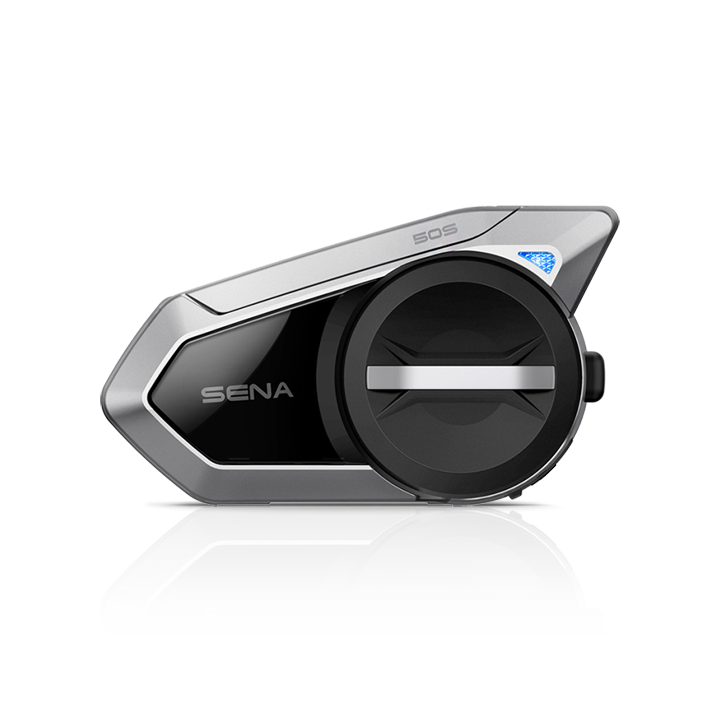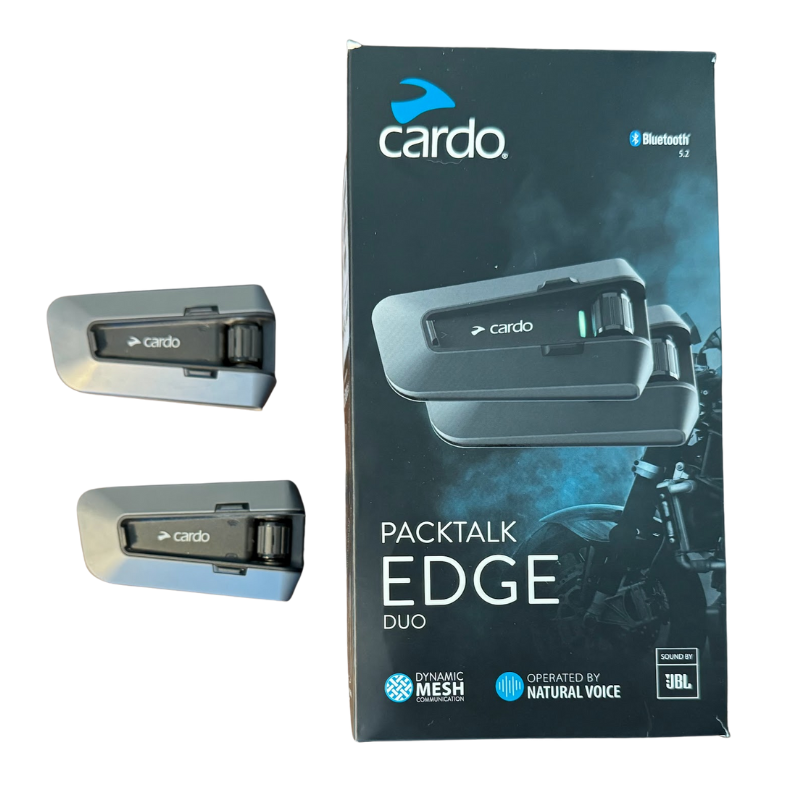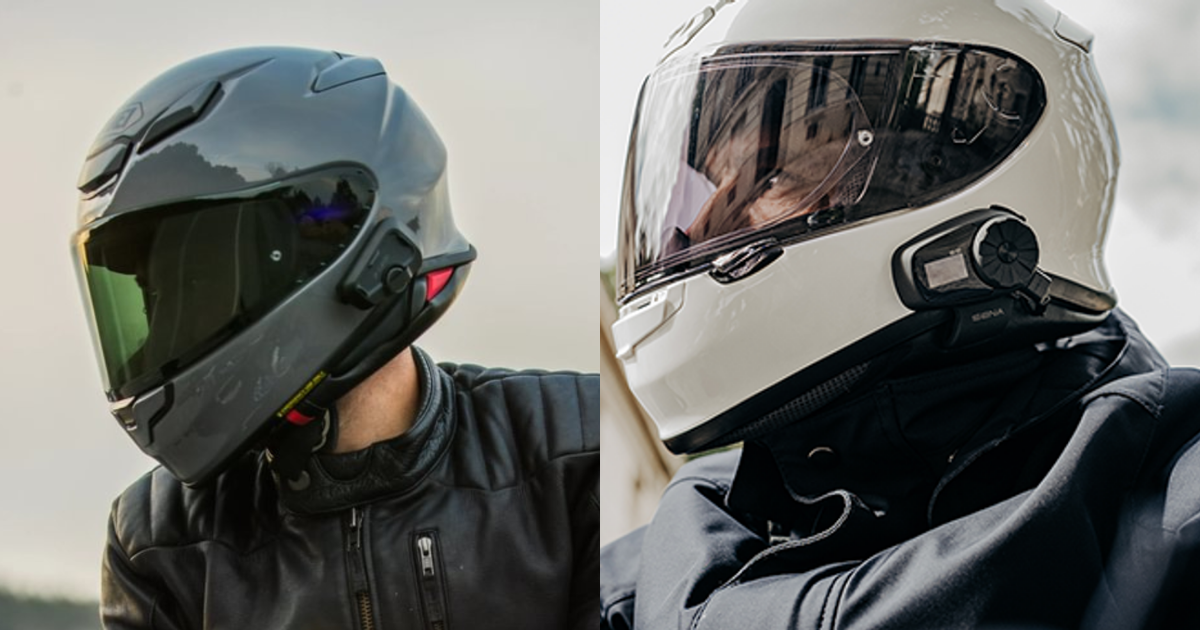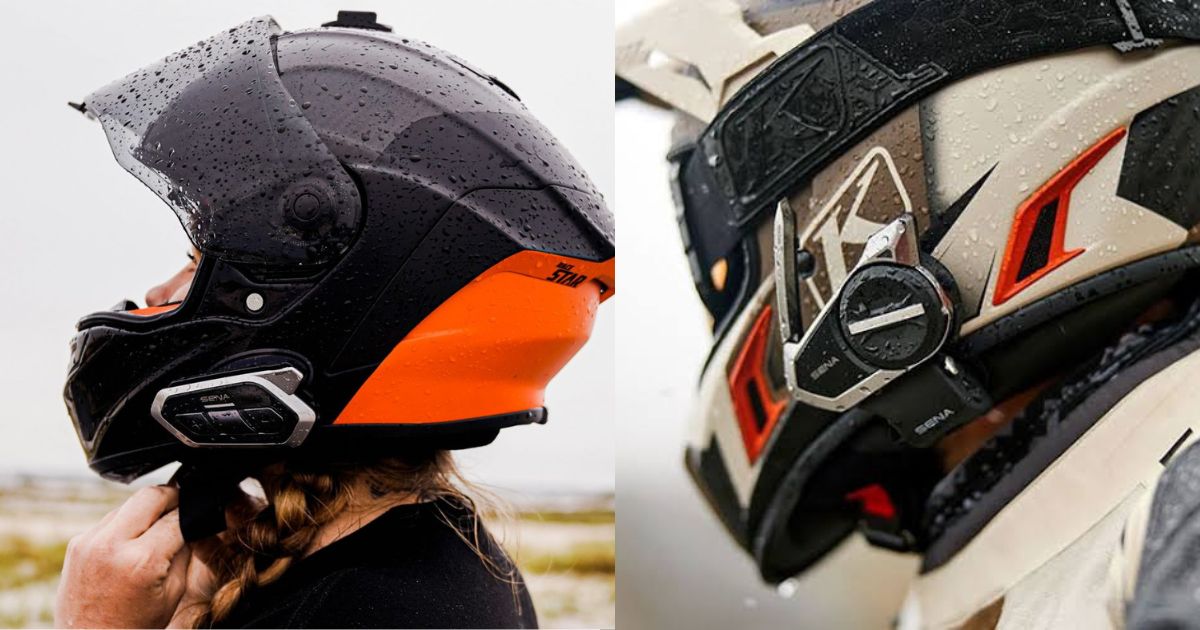
Sena 50S vs Cardo Packtalk Edge Communicator Comparison
left for contents
When it comes to motorcycle communicators, there was a time, not too long ago, maybe about five years back, when Sena pretty much owned the market. They had the name recognition, the market share – they were the go-to for Bluetooth devices on your helmet.
But then, things shifted.
Cardo, who had always been around, really stepped up their game. They gained a significant following, and now, these two brands are at the forefront, going head-to-head.
So which is better? I put them head to head to find out.

Premium Bluetooth intercom with Harman Kardon speakers and Mesh 2.0 tech for crystal-clear group communication and top-tier audio quality. | The Gold Standard in motorcycle communication units. Simple to use, reliable and waterproof, with clear JBL sound and long battery life. |
Premium Bluetooth intercom with Harman Kardon speakers and Mesh 2.0 tech for crystal-clear group communication and top-tier audio quality.
The Gold Standard in motorcycle communication units. Simple to use, reliable and waterproof, with clear JBL sound and long battery life.
The First Question to Ask Before Buying
Now, before we dive deep into the specifics of the Sena 50S and the Cardo Packtalk Edge – the top-of-the-line units I’ve been testing (a Sena 50S on my LS2 Vector 2 helmet and a Cardo Packtalk Edge on my RXT D4) – I need to underpin everything with one absolutely crucial question you must ask yourself before buying either:
Which one do your mates have?
Seriously, you can have the objectively ‘best’ unit, but if your riding buddies have a different brand, the connection experience is going to be annoying. It will lead to a worse riding experience and just won’t be as fun. So, figure that out first.
This article is based on this video review:
Key Takeaways from Actual Testing
Based on my time using both of these units side-by-side, trying to be as impartial as possible point-for-point, here are three key takeaways that might not be immediately obvious when you’re first looking into these devices:
- Real-world range doesn’t match the box: Both brands claim impressive mesh range (Sena 1.9-2 km, Cardo 1.6 km), but in my testing, neither unit consistently hit those numbers. Expect something closer to 900 to 1200 meters in typical conditions.
- Water resistance isn’t equal to waterproofing: Despite both claiming some level of water protection, Cardo’s IP67 rating gives a concrete guarantee against dust and water ingress, whereas Sena’s “water resistant” claim, while seemingly okay for the unit itself, has a potential weak point at the base station connection that can malfunction in heavy rain until it dries out.
- The ‘better’ app depends on your priority: While Cardo’s app offers more detailed customization and settings, Sena’s app feels a bit slicker, looks nicer, and connects to the unit more reliably and quickly in my experience.
Premium Bluetooth intercom with Harman Kardon speakers and Mesh 2.0 tech for crystal-clear group communication and top-tier audio quality. | The Gold Standard in motorcycle communication units. Simple to use, reliable and waterproof, with clear JBL sound and long battery life. |
Premium Bluetooth intercom with Harman Kardon speakers and Mesh 2.0 tech for crystal-clear group communication and top-tier audio quality.
The Gold Standard in motorcycle communication units. Simple to use, reliable and waterproof, with clear JBL sound and long battery life.
Range and Real-World Use
On the surface, both the Sena 50S and the Cardo Packtalk Edge perform similar core functions. They both offer multiple Bluetooth connections, Bluetooth intercom, mesh connectivity, and FM radio. Both also claim some form of water protection, although as I mentioned, that’s a point of contention we’ll get into.
What really sets both apart from other cheaper Bluetooth units is mesh connection technology. Sena calls it Mesh or Mesh 2.0, and Cardo calls it DMC, or Dynamic Mesh Communication (sometimes also referred to as connection). They’re essentially the same concept, allowing for a self-healing network where everyone is connected to everyone, unlike the old chain-like Bluetooth connections that would break if one rider dropped out.

Perhaps the most talked-about feature is range, and it’s what you’re going to rely on most when riding in a group. Cardo states 1600 meters (1.6 km) on the back of their box. Sena suggests a bit further, around 1.9 to 2 km. In my actual use, putting these claims to the test, neither brand reached their stated maximum range consistently. I found both units performed more in the 900 to possibly 1200-meter range.
It’s critical to remember that these claimed ranges are for ideal conditions – perfect line of sight, optimal atmospheric conditions, etc. When you introduce real-world obstacles like trees, hills, or the twisties that break the line of sight, the range will drop significantly. Both units are generally pretty good, and I’ve rarely felt truly limited by their range in typical riding scenarios, but once you lose that line of sight, they can drop out quickly.
One area where Cardo seemed to have an edge was in reconnection speed. If the connection dropped when line of sight was lost, the Cardo unit seemed to reconnect faster than the Sena unit. However, a major benefit of both the DMC (Cardo) and Mesh (Sena) systems is their self-healing nature. This means the network automatically reconfigures itself when riders drop out and rejoin, keeping everyone connected without needing manual intervention. This is a huge advantage over older Bluetooth intercoms where a dropped connection could break the entire chain.
Waterproofing: A Key Difference
Next up is waterproofing, and this is a significant difference between the two units. Cardo boasts an IP67 rating. IP stands for Ingress Protection, and the rating tells you how well the device is sealed against dust and water. IP67 specifically means it’s rated 6 (the highest level) against dust ingress and 7 against water ingress, which means it can withstand immersion in water up to 1 meter for up to 30 minutes. Cardo is confident enough in this rating that they state they will replace the unit if it dies due to water ingress.
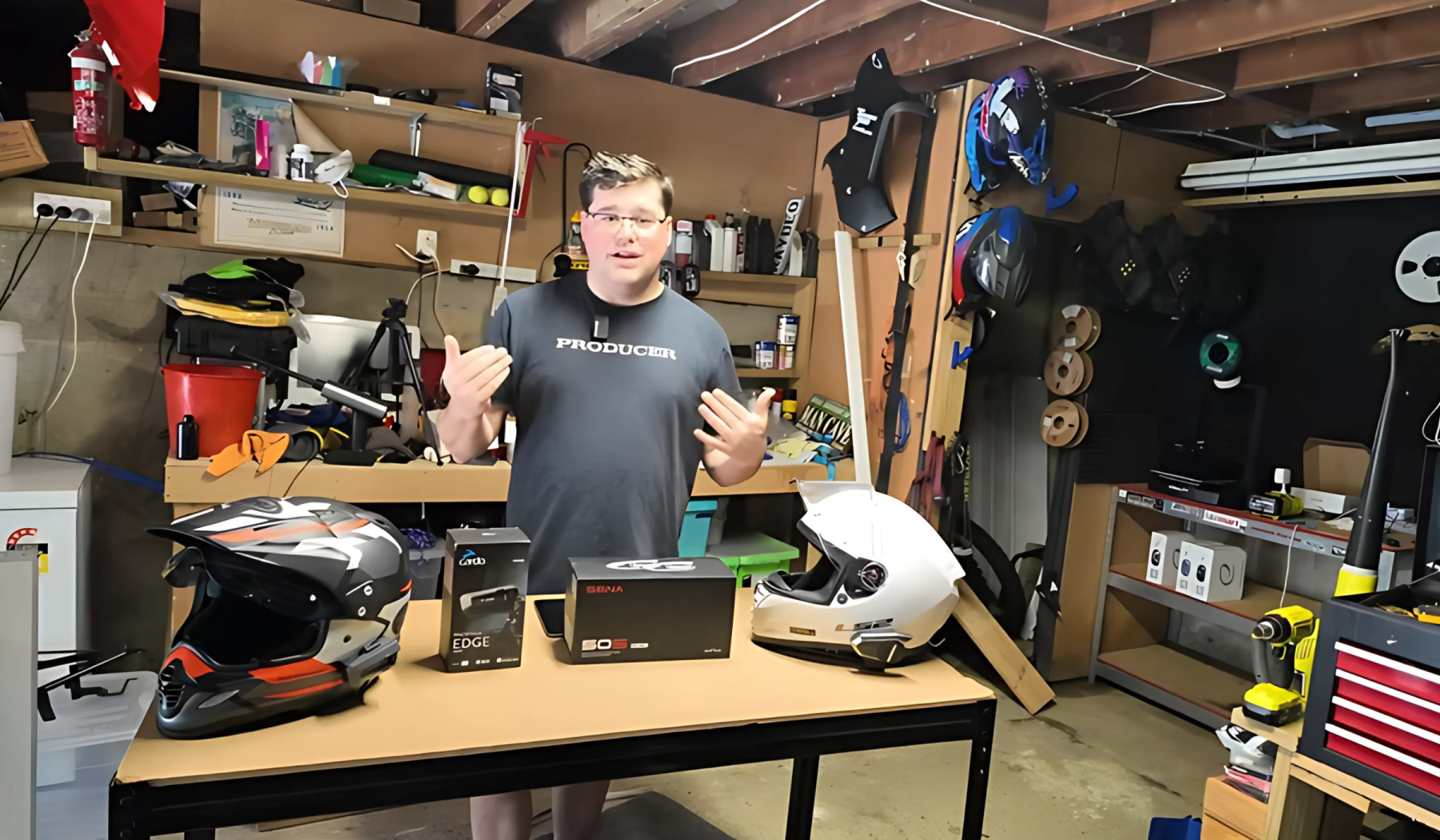
Sena, on the other hand, is not IP rated at all. They describe the unit as water resistant. In my personal use, the main Sena unit itself has generally been water resistant and hasn’t died from getting wet. However, the vulnerability lies in the connection point between the main unit and the base station mounted on the helmet. If water gets into this connector during a particularly heavy downpour, it can cause the unit to malfunction.
This has happened to me – the unit malfunctioned, and I needed to stop somewhere (like a cafe for a coffee) and dry out the connection point. Once it dried, it worked perfectly fine again. This is not a problem I have ever experienced with the Cardo Packtalk Edge or the Packtalk Bold that came before it. Not ever. This gives Cardo a clear advantage in this area, especially for riders who frequently encounter or expect to ride in the rain and want the peace of mind offered by a certified waterproofing standard.
Specs Comparison at a Glance
Here’s a quick run-down of some key stats for both units:
| Feature | Sena 50S | Cardo Packtalk Edge | Notes |
|---|---|---|---|
| Bluetooth Channels | 2 | 2 | For phone, GPS, etc. |
| Mesh Connectivity | Yes (Mesh 2.0) | Yes (DMC 2.0) | Different tech, not cross-compatible via mesh |
| Voice Commands | Yes | Yes | Trigger phone VA, internal commands |
| FM Radio | Yes | Yes | Integrated |
| Speaker Size | 40 mm | 40 mm | Standard size for helmet speakers |
| Speaker Manufacturer | Harmon Kardon | JBL | Renowned audio brands |
| Mounting Options | Clamp & Sticky Mounts | Clamp & Sticky Mounts | Versatility in helmet type |
| Microphone Types | Boom & Wired Mics | Boom & Wired Mics | For different helmet types (full-face vs. open-face) |
| Auxiliary Headphone Output | No | Yes | Can plug in your own headphones (3.5mm jack) |
| Claimed Range | 1.2 miles (1.9 km / 1900 m) | 1 mile (1.6 km / 1600 m) | Ideal conditions, real-world varies |
| App Control | Yes | Yes | Manage settings and updates |
| Button Control | Yes | Yes | Physical controls on the unit |
| Charging Port | USBC, Fast Charge | USBC, Fast Charge | Modern, convenient charging |
| Claimed Battery Life | 14 hours | 12 hours | Depends on usage (intercom vs. music) |
| Tested Battery Life | 13 hours | 13 hours | My personal experience was similar |
| Water Protection | Water Resistant | IP67 Rated | Key difference in reliability in rain |
Installation and Mounting Differences
When it came to installation, I found the Cardo unit slightly easier to get set up. The Sena was a bit more fiddly, mainly because it uses small Allen key grub screws to attach the clamping plates or adhesive mount to the base station. You also need to potentially undo screws to swap out microphone cables and such.
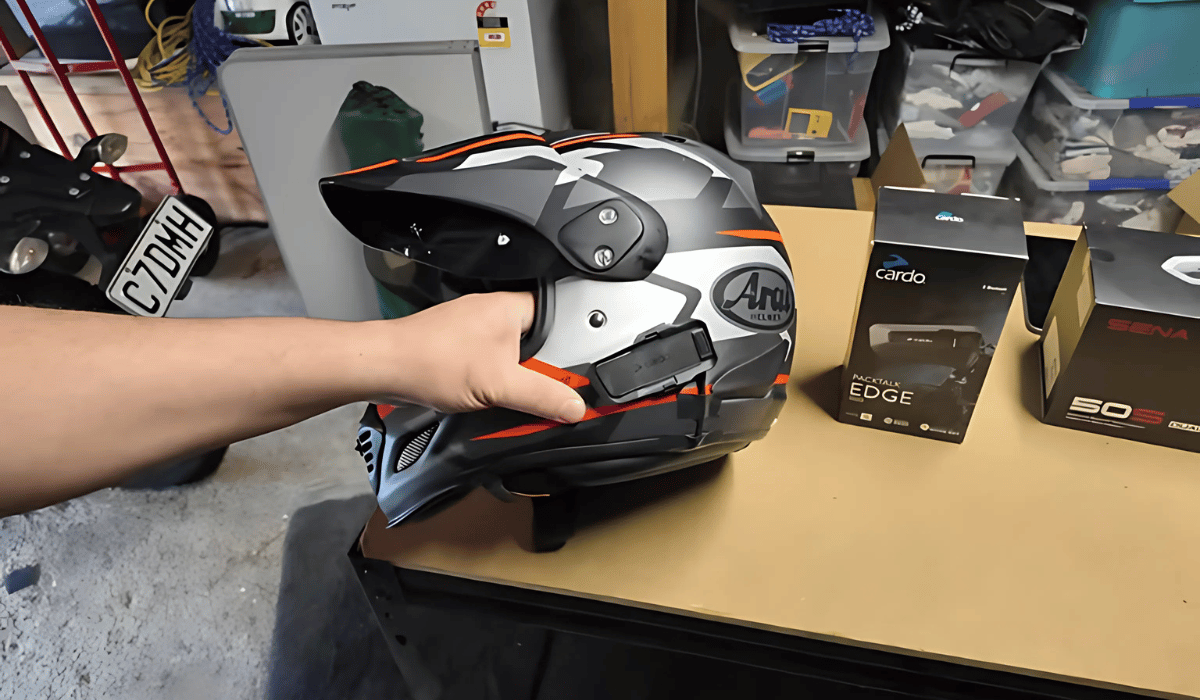
In contrast, the Cardo system’s wiring loom for the speakers and microphones comes out the bottom of the base station and terminates in easily accessible plugs. You can simply unplug the boom mic and plug in the wired mic, or swap headphones, just by unplugging and replugging.
Furthermore, the design of the Cardo mounting hardware felt more versatile. The unit detaches from the base station using a magnetic clip. To switch the base station from an adhesive mount (like the one I used on my helmet) to a clamp mount, you just release a little tab, slide one out, and slide the other in. It’s quick and tool-free for that part. The Cardo base station itself is also quite compact, similar in size to the unit.
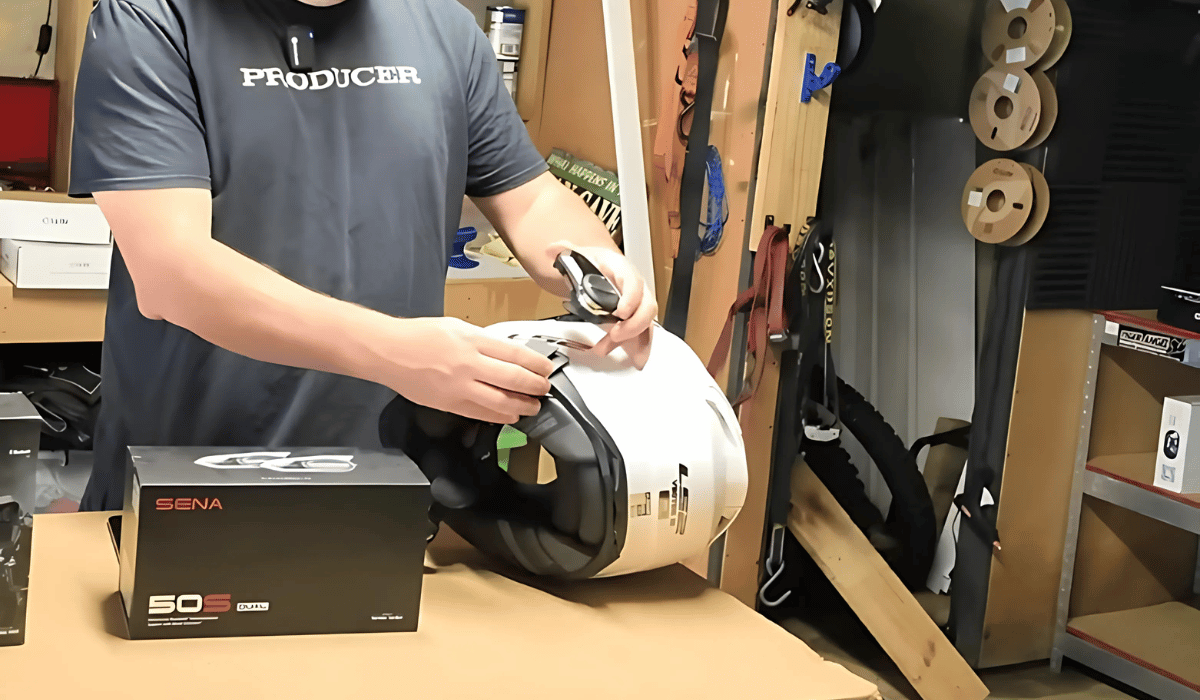
My experience with the Sena was different. When you take the main unit off its base station, you’re left with this larger chunk of hardware that needs to be mounted. This base station, which houses hardware and the microphone connection, needs to be installed on the bottom lip of the helmet in a specific spot. This makes the Sena potentially less versatile in terms of where it can be mounted on different helmet designs. The main Sena unit itself is also noticeably larger than the Cardo counterpart. Overall, in terms of mounting ease and versatility across various helmet types, I’d have to give the nod to Cardo. They’ve really nailed it there.
Mesh Connection Features
Where the Sena does offer something unique compared to the Cardo is its approach to mesh connection. Sena provides two types of mesh. You can set up a direct mesh connection, which is a private group for four or five of your friends where you all join the same channel. This is similar to Cardo’s DMC group. However, Sena also offers open mesh, which provides nine available channels. This operates more like a traditional RT radio – anyone on that specific open mesh channel can hear you and join the conversation. I quite like this feature; I think it’s a good option for larger rides or events where you want more open communication.
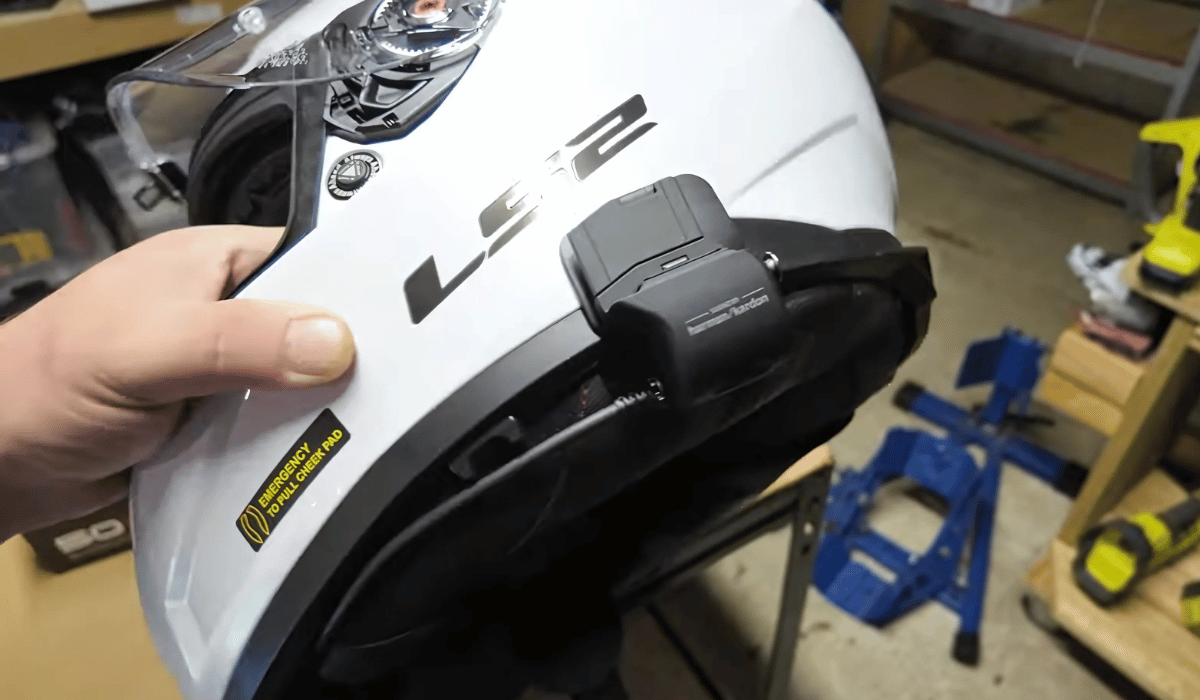
Adding to the Sena’s capabilities is the MeshPort Red accessory. This allows you to pair the mesh audio to a camera, making it easy to get a group recording of the conversation happening on your open mesh channel.
Cardo, on the other hand, primarily focuses on point-to-point connections for groups through their DMC. You gather your mates, hit connect, one person manages the group, and that’s your conversation. You can add more people to this group, but it’s a manual process to join the specific DMC session. There is no equivalent to Sena’s open mesh channel system.
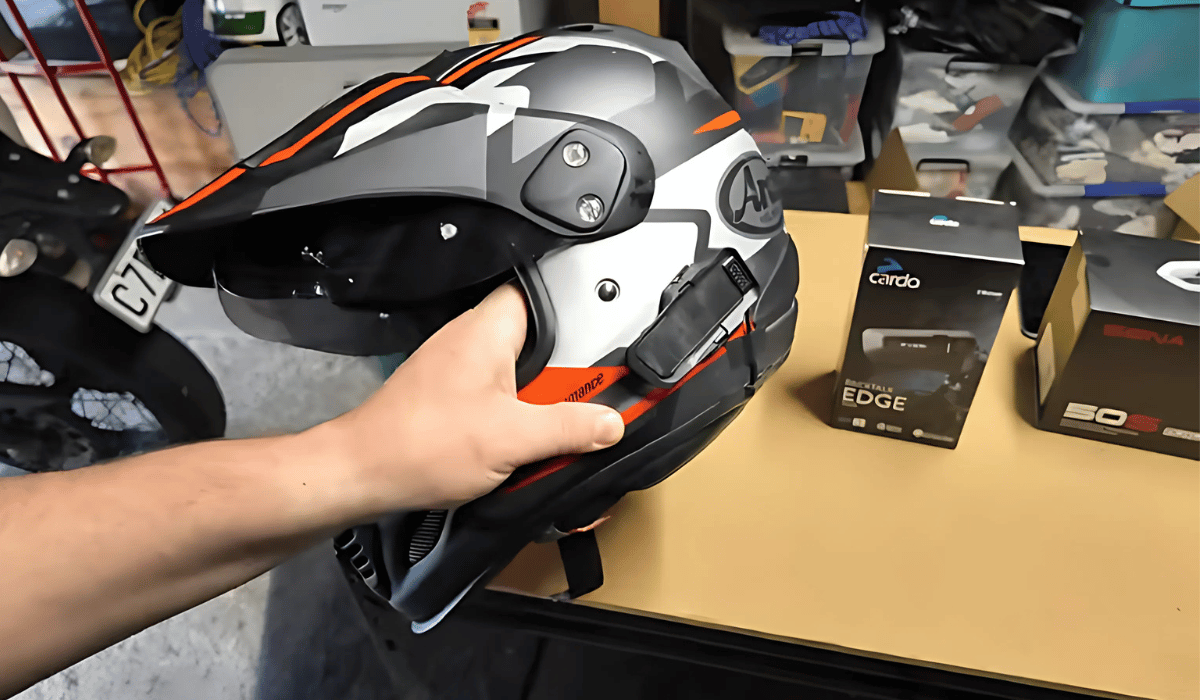
Bridging Sena and Cardo Groups
At the time I’m recording and writing this, it is possible to bridge a group of riders on a Cardo mesh system with a group of riders on a Sena mesh system. The way you do this is by having one rider from the Cardo group and one rider from the Sena group establish a Bluetooth bridge between their individual units. This bridge then allows everyone in the Cardo mesh group and everyone in the Sena mesh group to talk to each other through that single Bluetooth connection.
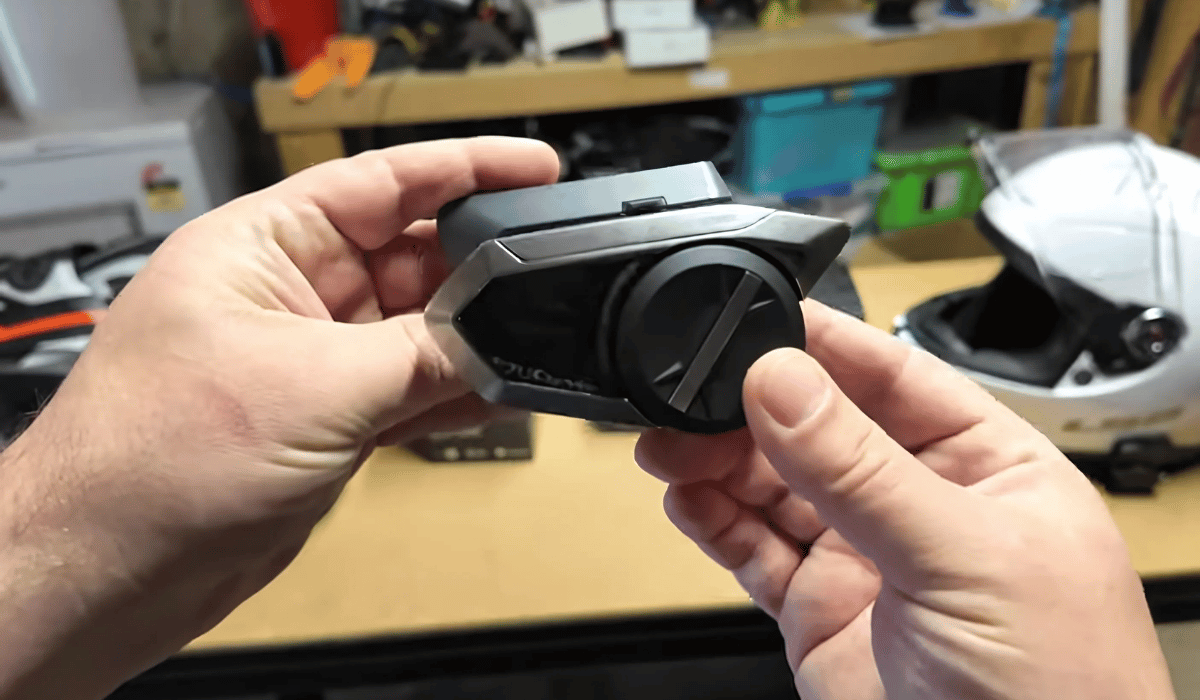
The limitation here is that those two specific riders creating the bridge need to stay relatively close to each other, generally within a couple of hundred meters, for that Bluetooth connection to remain stable. If that connection drops out, the bridge is broken, and the two mesh groups can no longer communicate.
Cardo’s system does have a feature where the unit will attempt to automatically reconnect the Bluetooth bridge for up to five minutes if it’s lost, which is quite a thoughtful touch. It suggests Cardo is trying to make the integration between the two different systems more fluid and easier to manage for riders who might have mixed-brand groups.
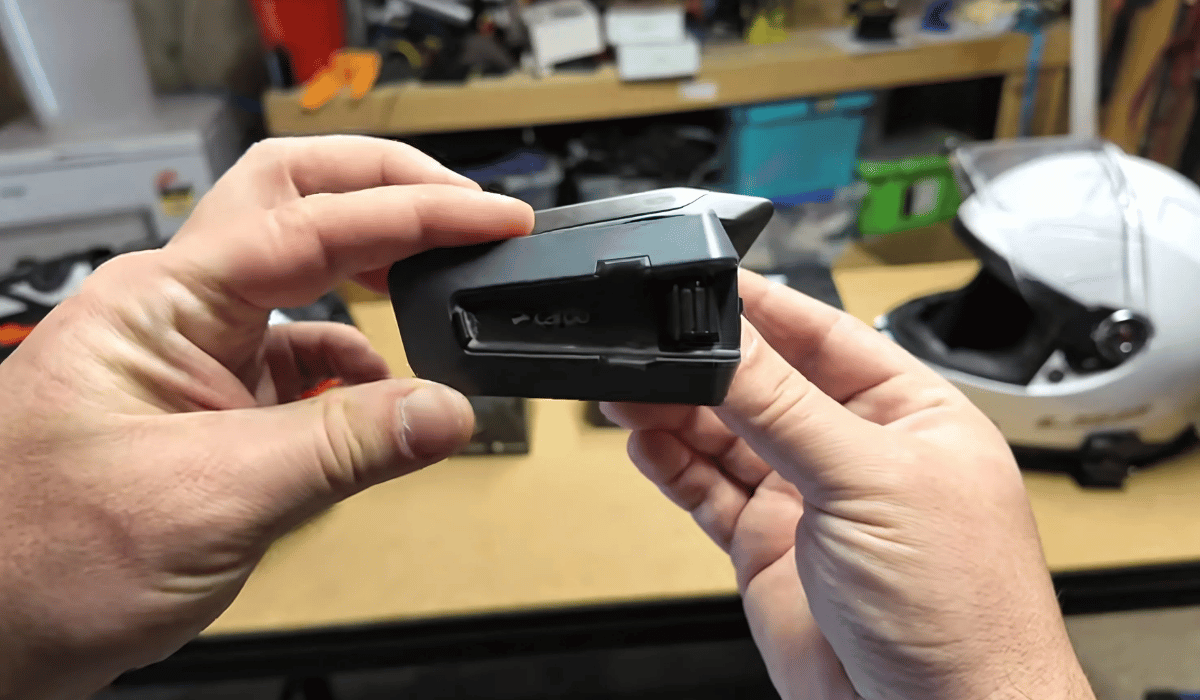
However, despite the technical possibility, in my experience, this bridging process is still a bit fiddly. It’s not something I see most people doing regularly. This sort of on-the-fly connection management needs to be dead simple, ideally just a couple of button presses or a quick app interaction with minimal waiting or messing around. Riders are usually geared up, on the side of the road, and keen to get going. If connecting the groups is complicated, you likely just won’t bother.
Firmware Updates
Both units offer over-the-air (OTA) firmware updates through their respective smartphone apps. This is a great feature because it means you don’t have to take the unit off your helmet, plug it into a computer, and run update software. You can do it all wirelessly via your phone. In my testing, the Cardo OTA updates have worked flawlessly every time. The Sena OTA update function, however, didn’t work for me initially.
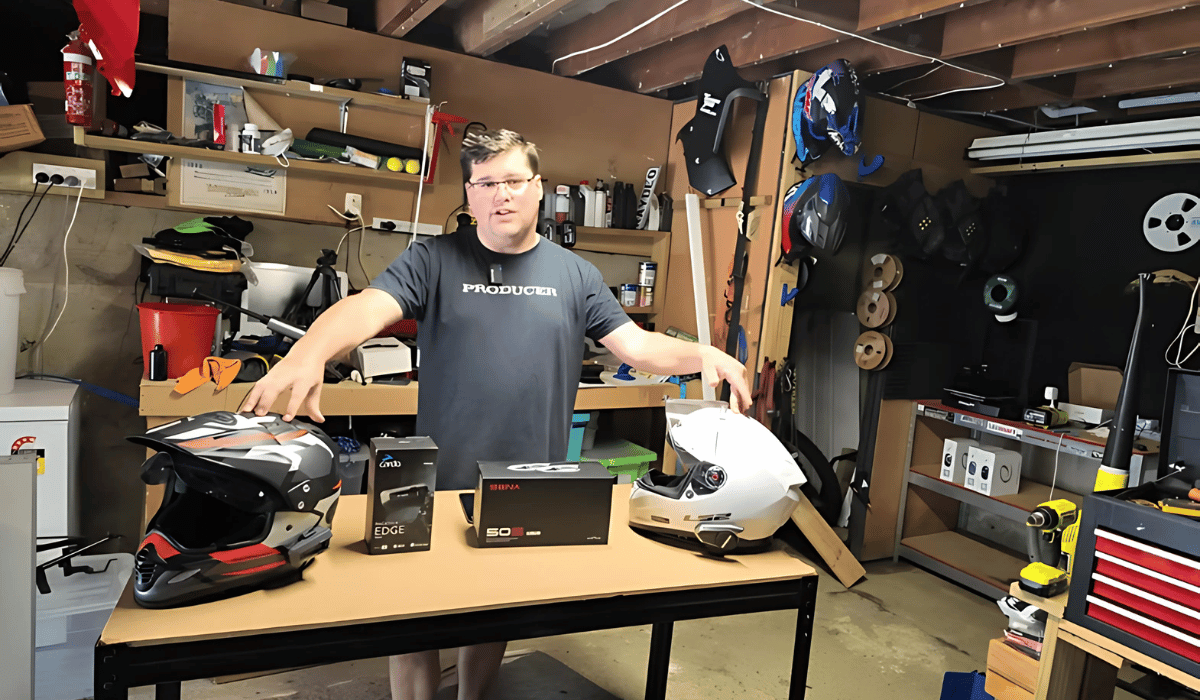
When I first got the Sena out of the box, I saw the option in the app, but it wouldn’t connect to perform the update. I had to plug the Sena unit into my computer to get the initial firmware update done. It’s possible this was just due to the unit shipping with factory firmware and subsequent updates would work OTA, but I can’t confirm that. What I can confirm is that out of the box, the Cardo OTA worked, and the Sena’s didn’t.
Sena does include a USB Wi-Fi dongle with the 50S. You plug this into a power source and the unit, connect the dongle to your home Wi-Fi network, and it can perform automatic updates that way. Cardo does not offer a similar dongle.
Apps and Usability
Speaking of the apps, I personally think Sena’s app looks a bit nicer and is slightly easier to navigate and use. It feels more intuitive. Cardo’s app can sometimes feel a bit trickier to use, and I’ve had occasional issues with it not connecting to the unit easily on the first try. However, Cardo’s app generally offers more functionality and more detailed options for customizing the settings and the overall listening experience. If you’re someone who likes to tweak every possible setting, Cardo’s app provides more depth. If you prefer a cleaner, more straightforward interface and quick, reliable connection, Sena’s app might appeal more.
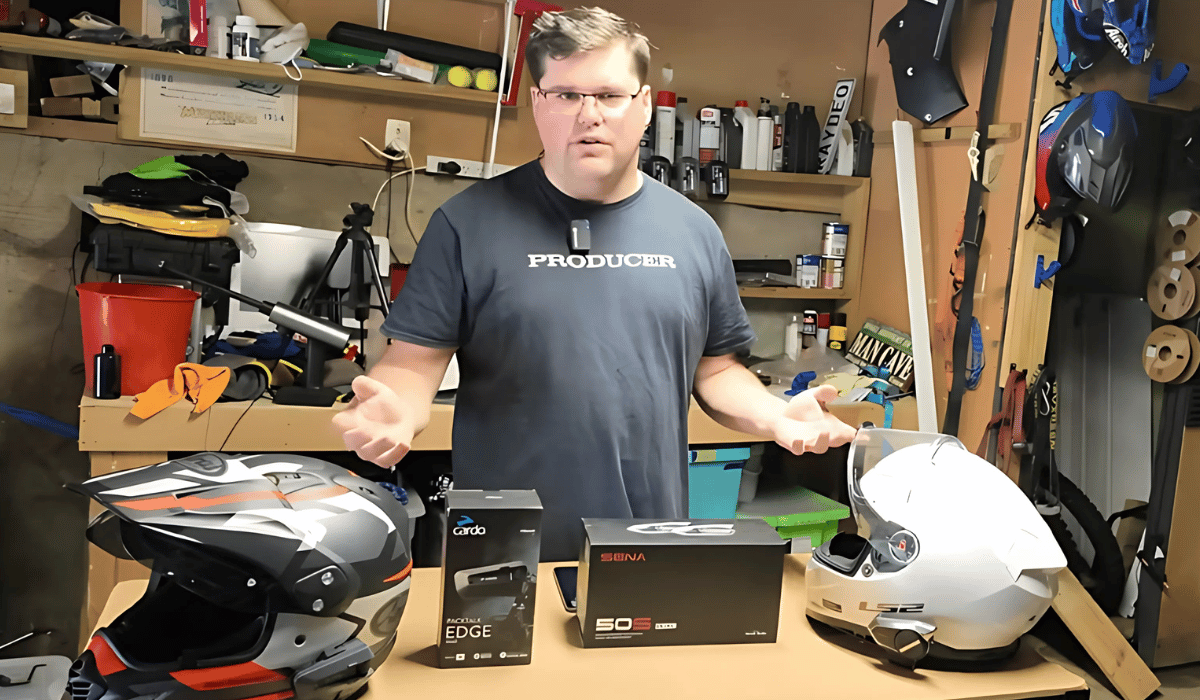
Sound Quality
The sound quality from both units is generally good. They both use 40mm speakers made by reputable audio companies – Harmon Kardon for Sena and JBL for Cardo. To be completely honest, in real-world riding conditions, I couldn’t discern a significant difference in sound quality between the two speaker sets. The biggest factor impacting the sound experience wasn’t the speaker brand, but rather the specific helmet I was using and how well the speakers fit into the helmet’s speaker pockets and how close they were to my ears.
The best of the best, this collaboration with audio giant JBL delivers crisp highs and booming lows along with enough power to overcome wind and road noise.
- Clear sound even at 90+mph
- Balanced sound even at full volume
- Hear your intercom, music and GPS at once.
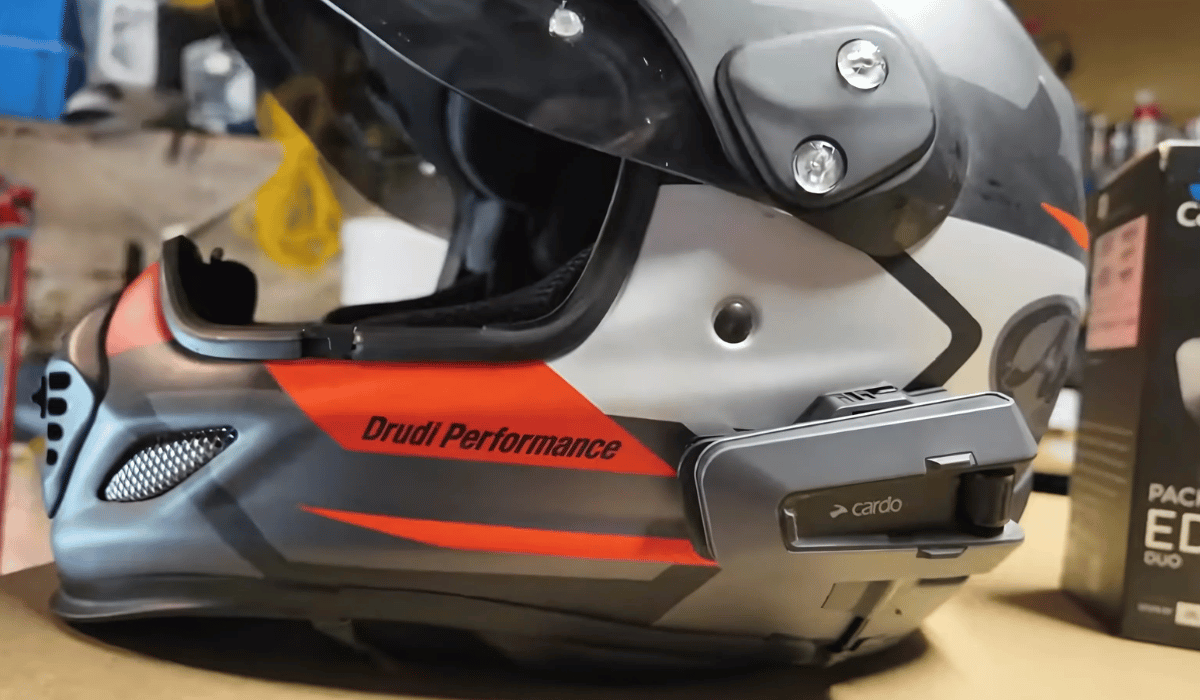
For the best sound quality, it’s crucial that the speakers are positioned correctly, right by your ears. You can have a couple of millimeters gap, and that’s usually fine, but if they’re too far forward, too far back, or not perfectly centered over your ears, the sound quality will be diminished. Comfort is also key. If the speakers are pressing uncomfortably against your ears, it can ruin your riding day.

You can often use included spacer pads to adjust the fit and get it just right for comfort and optimal speaker placement. But in my experience, running both units on different helmets, they both sounded great when installed correctly. The acoustics and construction of the helmet itself seemed to have a bigger impact on the bass, clarity, and overall sound experience than the specific speaker brand.
Controls and Voice Commands
Both units rely on combinations of physical buttons on the unit for various functions (volume, changing modes, initiating intercom, etc.). Remembering these combinations can take a little practice, but if you’re primarily using just one unit, you’ll likely get the hang of it quickly. And if you don’t want to memorize button sequences, both units can be largely controlled via their smartphone apps once they’re turned on, so you really only need to remember how to power them up. I can’t definitively say one unit’s button interface is “better” than the other; it’s just a different layout and different combinations to learn.
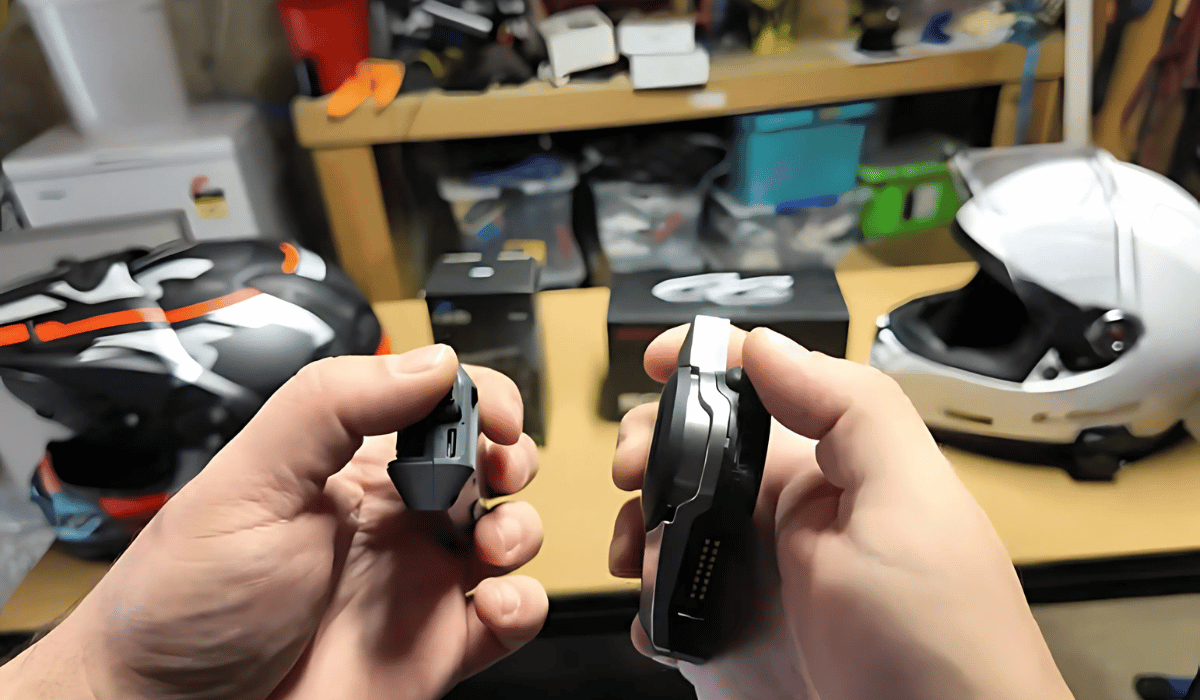
Both units offer voice command control, allowing for hands-free operation. They often refer to this as natural voice operation. This includes triggering your phone’s virtual assistant (like Siri or Google Assistant) and also having internal voice commands specific to the unit itself (like “Hey Cardo, Volume Up” or “Hey Sena, Music On”).
In my testing, the Cardo voice commands worked reliably, including triggering the virtual assistant on my phone and the internal unit commands, right out of the box. The Sena unit’s voice commands were a bit less consistent for me. While I could trigger the virtual assistant on my phone, the internal voice commands (like “Hey Sena, volume up”) never seemed to work as expected, and I couldn’t figure out which setting might need changing to make them functional. So, for voice control, the Cardo felt more polished and functional out of the box.
Battery Life
Battery life is another important consideration, especially for longer rides. Sena claims up to 14 hours of talk time on mesh, while Cardo claims up to 12 hours on DMC. Both units charge via USBC and support fast charging, which is a great convenience. In my actual use, testing the battery life under similar conditions (a mix of intercom use, music streaming, and standby), I found the performance was quite close.
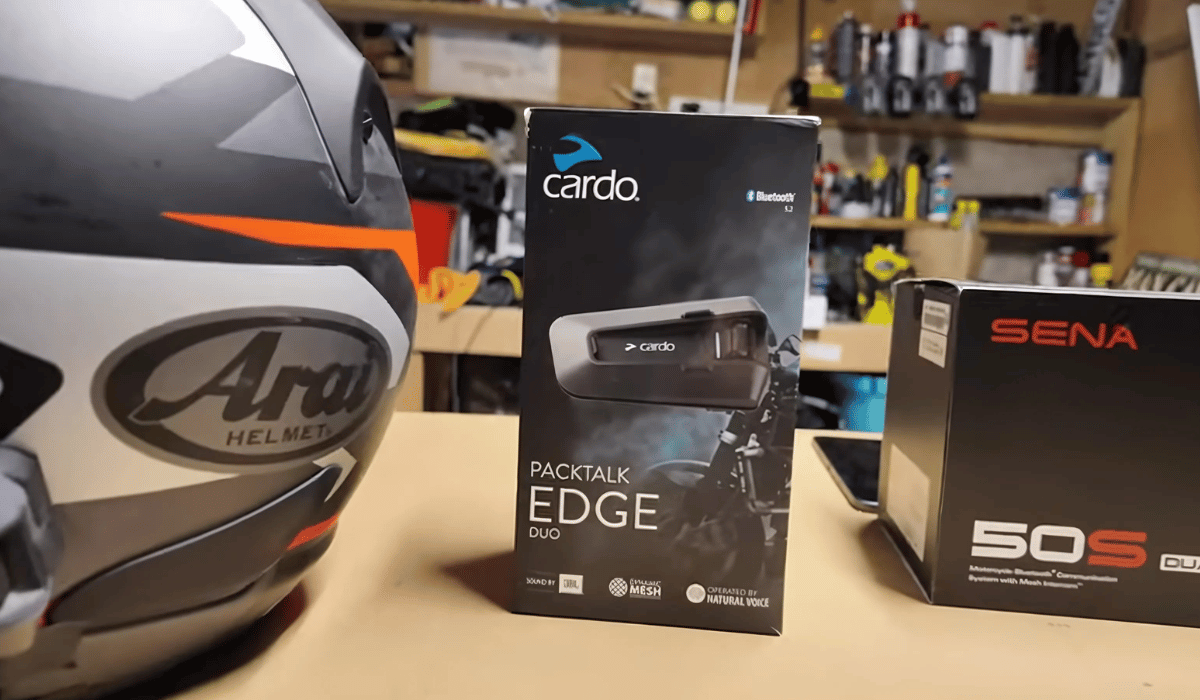
I easily got 12 hours out of the Cardo and actually managed about 13 hours, which exceeded the claim. With the Sena, I also got around 13 hours, which was one hour less than its claimed 14 hours. So, while Sena claims slightly more, in my experience, the real-world battery life was very similar, around 13 hours for both.
Love a helmet that only fits a specific comms unit?
HJC, Shoei, Schuberth, Nexx and even Harley all try to force you in to custom-fit comms units that may not fit how you ride. So Tubs Jackson created an adapter to get a factory fit for any comms unit on these otherwise amazing helmets.
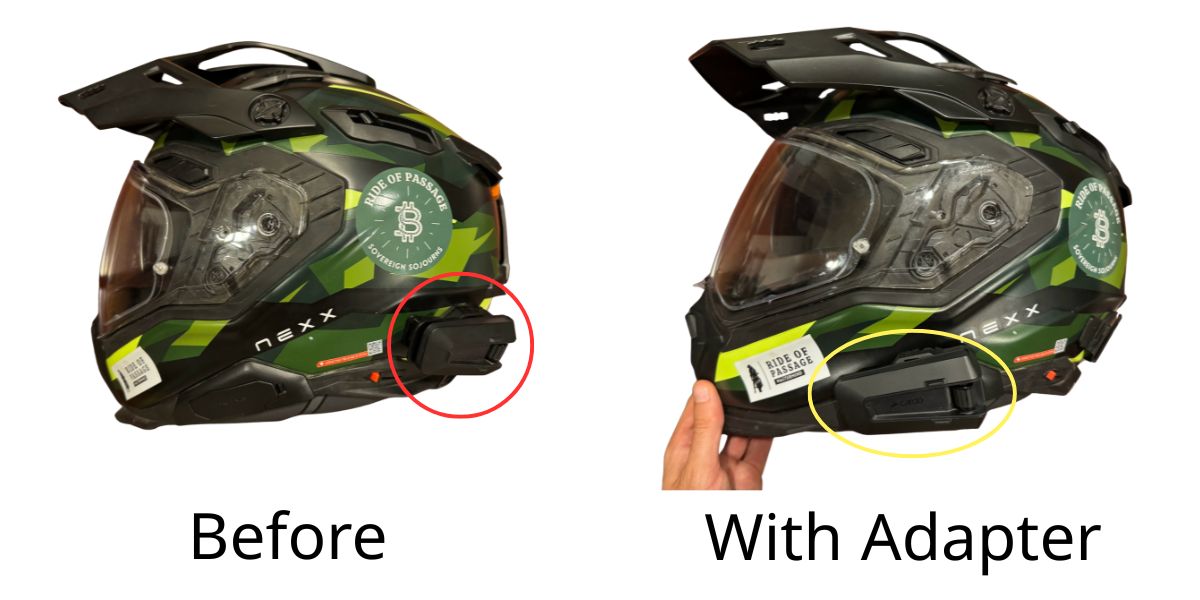
Tubs Jackson is a weird name, I know, but I have their adapter in my Nexx X.WED3 helmet and it’s rock solid. Much nicer than reaching way back to where I had the sticky mount before. I wish I’d thought of this idea.
Tip: Get FREE SHIPPING just by buying here or using code BETTERONTHEROAD at checkout.
Final Verdict
After putting both the Sena 50S and the Cardo Packtalk Edge through their paces, riding with them for commuting and occasional group rides, it boils down to this: both are good pieces of gear. Both units do the job they’re designed to do, and mostly, they live up to their advertised features.
But which one is “better”? For me, personally, I have to lean towards the Cardo Packtalk Edge. There are a few key reasons for this.
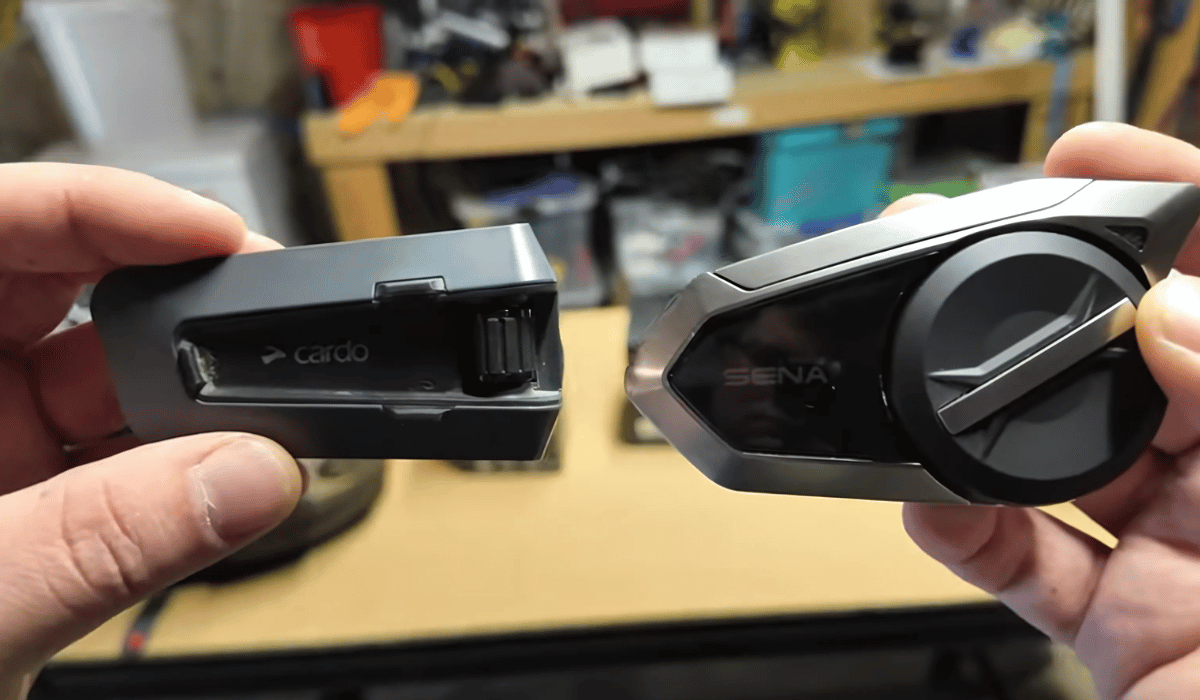
First, the fit and form factor. The Cardo’s more versatile mounting options mean it fits a wider variety of helmets easily, and the unit itself is smaller and less bulky, which I feel reduces wind resistance on the side of the helmet.
Second, and this is a big one for me, is the waterproofing. I don’t want to be out on a multi-day ride, see a storm brewing on the horizon, and start worrying about whether my communicator is going to survive a heavy downpour or if the connection point is going to malfunction. The Cardo’s IP67 rating provides a solid level of assurance, and knowing that Cardo stands behind it by offering replacement if water ingress causes failure gives me peace of mind. Sena’s “water resistant” claim just isn’t strong enough to alleviate that concern for me.
Third, while the apps and voice commands had slight differences in my experience (Sena’s app nicer, Cardo’s voice commands more reliable), the core functionality of mesh intercom, music, and GPS navigation worked well on both when installed correctly.
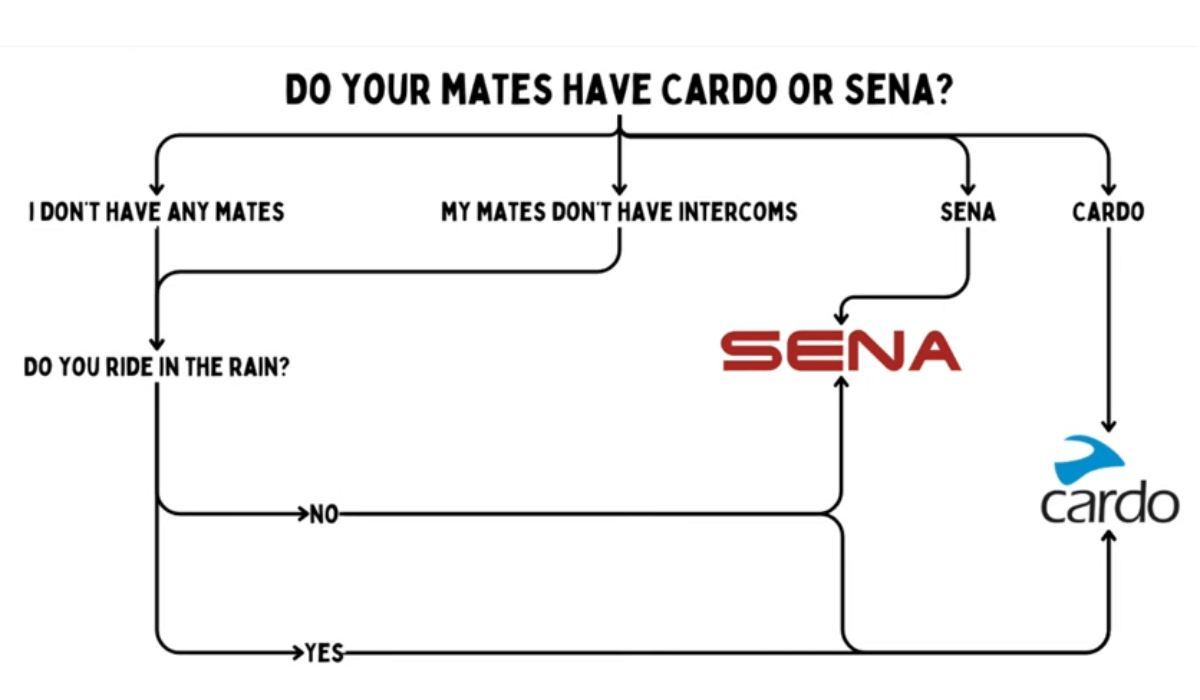
It’s a tough call because both deliver on the core promise of keeping you connected and entertained on the road. What I want from a communicator is reliability: when I’m commuting, I want it to connect instantly to my phone for turn-by-turn directions, music, or podcasts. When I’m riding with friends (which for me might only be five times a year, max), I want it to connect quickly and reliably to their units. I find myself reaching for the Cardo more often than the Sena.
Ultimately, the price point for these top-tier units is basically the same. Given the similar core performance, the difference in waterproofing and the mounting versatility of the Cardo push it slightly ahead for me.
But remember that fundamental question: what do your mates run? If everyone you ride with has Sena, getting a Sena 50S is probably the pragmatic choice, despite the points I’ve raised here. A slightly less-favored unit that connects seamlessly with your group will almost always provide a better overall riding experience than the technically superior unit that leaves you isolated.
Premium Bluetooth intercom with Harman Kardon speakers and Mesh 2.0 tech for crystal-clear group communication and top-tier audio quality. | The Gold Standard in motorcycle communication units. Simple to use, reliable and waterproof, with clear JBL sound and long battery life. |
Premium Bluetooth intercom with Harman Kardon speakers and Mesh 2.0 tech for crystal-clear group communication and top-tier audio quality.
The Gold Standard in motorcycle communication units. Simple to use, reliable and waterproof, with clear JBL sound and long battery life.
If you’re just looking for a communicator for solo riding – music, GPS, phone calls – or if the price of these top-of-the-line mesh units is a bit steep, there are many other, more cost-effective options out there. Some of them still offer Bluetooth intercom and core features you might need.
Read another opinion on switching from Sena to Cardo:
Related
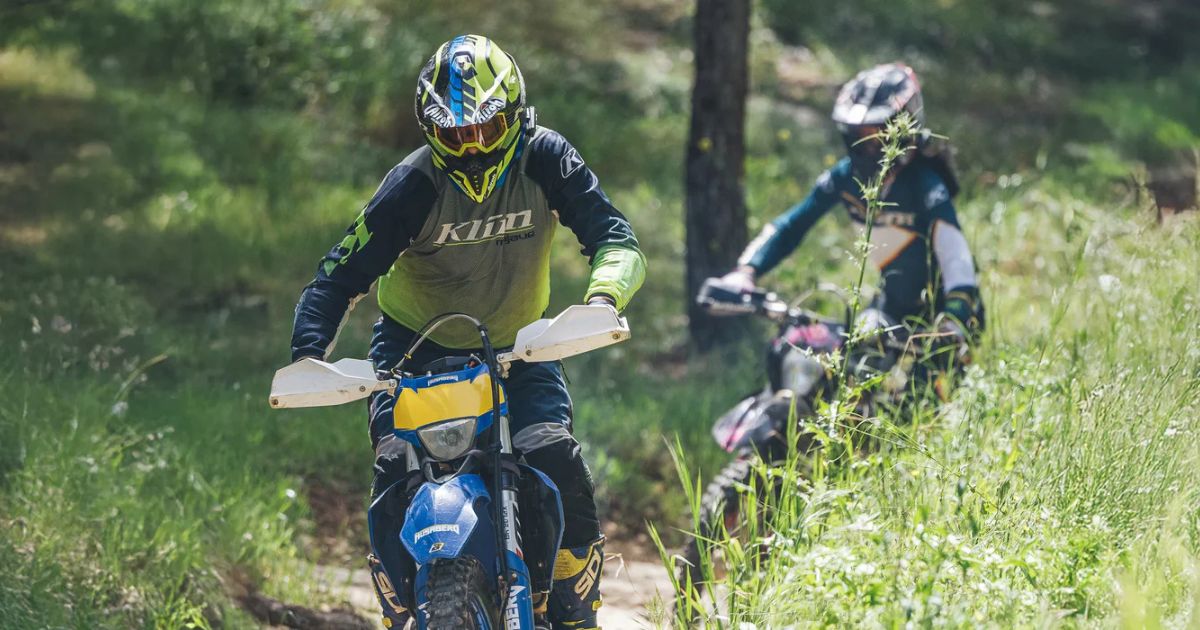
Best Cardo Communicators for Motorcycle Riders
Find the best Cardo communicator for your rides—compare mesh, Bluetooth, sound, and features to match your budget, group size, and style.

